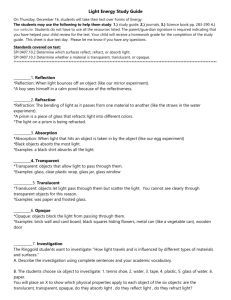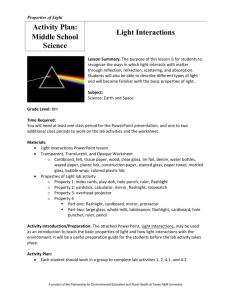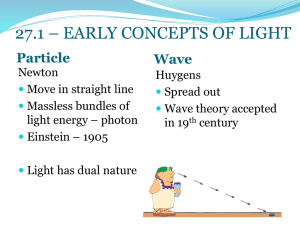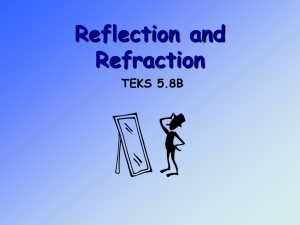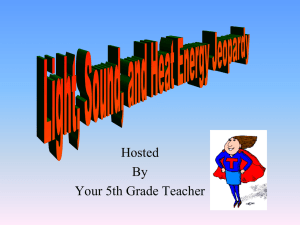FINALiPadStemLessonPlanBankerCampbell
advertisement
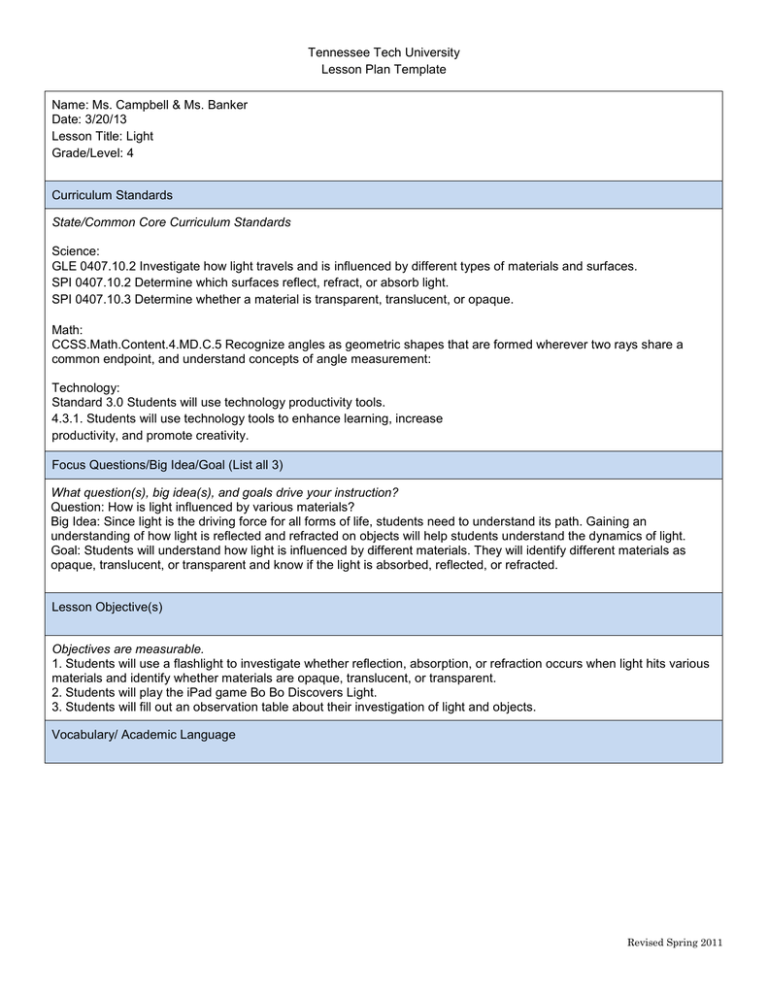
Tennessee Tech University Lesson Plan Template Name: Ms. Campbell & Ms. Banker Date: 3/20/13 Lesson Title: Light Grade/Level: 4 Curriculum Standards State/Common Core Curriculum Standards Science: GLE 0407.10.2 Investigate how light travels and is influenced by different types of materials and surfaces. SPI 0407.10.2 Determine which surfaces reflect, refract, or absorb light. SPI 0407.10.3 Determine whether a material is transparent, translucent, or opaque. Math: CCSS.Math.Content.4.MD.C.5 Recognize angles as geometric shapes that are formed wherever two rays share a common endpoint, and understand concepts of angle measurement: Technology: Standard 3.0 Students will use technology productivity tools. 4.3.1. Students will use technology tools to enhance learning, increase productivity, and promote creativity. Focus Questions/Big Idea/Goal (List all 3) What question(s), big idea(s), and goals drive your instruction? Question: How is light influenced by various materials? Big Idea: Since light is the driving force for all forms of life, students need to understand its path. Gaining an understanding of how light is reflected and refracted on objects will help students understand the dynamics of light. Goal: Students will understand how light is influenced by different materials. They will identify different materials as opaque, translucent, or transparent and know if the light is absorbed, reflected, or refracted. Lesson Objective(s) Objectives are measurable. 1. Students will use a flashlight to investigate whether reflection, absorption, or refraction occurs when light hits various materials and identify whether materials are opaque, translucent, or transparent. 2. Students will play the iPad game Bo Bo Discovers Light. 3. Students will fill out an observation table about their investigation of light and objects. Vocabulary/ Academic Language Revised Spring 2011 What opportunities will you provide for students to practice content language/vocabulary and develop fluency? Reflect - To throw or bend back from a surface. Refract - To deflect (light, for example) from a straight path by refraction. Absorb - To retain (radiation or sound, for example) wholly, without reflection or transmission. Light - Electromagnetic radiation that has a wavelength in the range from about 4,000 (violet) to about 7,700 (red) angstroms and may be perceived by the normal unaided human eye. transparent-having the property of transmitting light without appreciable scattering so that bodies lying beyond are seen clearly Translucent-Allowing light, but not detailed images, to pass through; semitransparent. Opaque- an object is neither transparent (allowing all light to pass through) nor translucent (allowing some light to pass through). Angle - Geometric shapes that are formed wherever two rays share a common endpoint. Transparent - Capable of transmitting light so that objects or images can be seen as if there were no intervening material. Students will use the academic vocabulary on their graphic organizers and on the exit ticket. Material/Resources What do you need for this lesson? light powerpoint graphic organizer with pictures light observation chart prism aluminum foil Each group of 3-4 will need: laser mirror glass cardboard wax paper iPad - Bobo Explores Light app by Game Collage, LLC Assessment/Evaluation Formative: How will students demonstrate understanding of lesson objective(s)? How will you monitor and/or give feedback? Throughout the lesson, the teacher will monitor students for understanding. Also, the teacher will continually ask questions to make sure that students understand new material. During questioning and conversation, the teacher will assess students’ academic growth. If a student verbalizes an incorrect answer or misconception, the teacher will correct the misconception and present the correct answer to the class. During the laser light activity, the teacher will walk around and listen to the students’ discussions. If the students are off task or lacking knowledge, the teacher will redirect their attention to the task or specific observation that would help them understand what is going on. Also, the teacher will provide specific feedback throughout the lesson, giving them recognition for their scientific inquiry and thought process and redirecting and correcting misconceptions. During the Bo Bo Discovers Light game, the teacher will ask probing questions to lead them into higher order thinking. The teacher will ask them questions like what if? When the student makes a prediction, the teacher will gain a perspective on how the students understand the material. If a student makes a wrong prediction, the game will show them. Then the teacher will ask them why they think something else happened and if they understand their mistake. Summative: What evidence will you collect and how will it document student learning/mastery of lesson objective(s) In order to check for mastery, the teacher will collect their observation charts. If students correctly identify each light reaction to a material, they will have mastered the basic concepts of light travel. Also, the teacher will collect the students’ exit tickets to see how much they have learned or if they have learned anything new. Revised Spring 2011 Instruction (Include a suggested time for each major activity) List Questions for higher order thinking These cannot be answered by yes or no. (Identify Bloom’s Level of Thinking) *This section of the lesson should last approximately 10 minutes* Set/Motivator: How will you engage student interest in the content of the lesson? Use knowledge of students’ academic, social, and cultural characteristics. Evaluation: What is occurring with the light? Before the lesson begins, the teacher will ask the students to put their hands on their head if they know how light works and reflects and refracts off of objects. If a student already says they know the topic. The teacher will ask them to explain. Students will be given the opportunity to share their background knowledge on the topic of light. Advanced students will be given an opportunity to use the iPad to further explore the topic of light and increase their understanding. The teacher will begin the lesson by shining a light through a prism. Next, the teacher will explicitly point out the way the light shines out of the prism. Then the teacher will ask various probing questions about what is happening with the prism and the light. This demonstration will serve as both a motivator to get the students thinking about how light travels and a pre-assessment to activate students’ prior knowledge. The teacher will introduce students to the concepts of reflection, refraction, and absorption using a graphic organizer with photographs to provide students the opportunity to collect information about the processes. Knowledge: Is it being reflected, refracted, or absorbed? Knowledge: Is the prism transparent, translucent, or opaque? *This section of the lesson should last approximately 40 minutes* Instructional Procedures/Learning Tasks: Provide specific resources/details of lesson content and delivery. Analysis: Why do you think the light would not shine through the cardboard? Part I: 10 mins In order to continue the lesson, the teacher will lead the discussion into a short slideshow introducing light and how it reflects or refracts off of various materials. During this part of the lesson, the teacher will carefully describe specific examples to further students’ understanding. During the slideshow the teacher will ask various questions to check for understanding. Students will also identify whether materials are opaque, transparent, or translucent. By the end of the slideshow, the teacher will ask students to put their fingers on their nose if they understand light and how it travels through different materials. The teacher will also ask the students if they have any more questions before continuing with the lesson. Part II: 20 mins After the slideshow the teacher will group the students into small cooperative groups for an activity. The teacher will explicitly explain the steps in the activity and model the steps in the activity. The teacher will ask the students to shine the light on each object, sketch their observations of each material in the chart, and decide whether the flashlight is reflecting, refracting or being absorbed into each material. Next, the teacher will ask the students to pinpoint the endpoint of the angle of the light beam in their sketches. The teacher will model how to conduct the activity by using a laser light and aluminum foil. The teacher will show students how to record the information on the chart and answer the three questions. In order to check the students’ understanding of the directions, the teacher will ask a student to repeat the directions. In order to help the students with answering the questions, the teacher will encourage students to use their graphic organizers to help them during this activity. The teacher will discuss the guidelines for using the lasers and let them know that groups that do not follow safety directions will not be allowed to continue using the lasers. The teacher will hand out a laser, mirror, glass piece, wax paper piece, cardboard piece, and observation chart to each group. Part III: 10 mins After the students complete the activity, the teacher will show the students how to Synthesis: Can you think of a different material that the light would shine through? Why? Analysis: When you moved the lasers in the BoBo Discovers Light game, how did the angles of the light change? How did you make the angles larger and smaller? Evaluation: What do you think would happened if you shined a light on metal? Why? Revised Spring 2011 play the Bobo Explores Light iPad app. The teacher will ask the students to complete three specific tutorials on the game. Students will use the reflection, refraction, and the combined reflection and refraction sections on the app. They will ultimately have to share something they have learned from the activity and the game in the closure. While the students are playing on the game, the teacher will walk around to assess how well the students understand the material. The teacher will be available for questions that may arise during the activity. This section of the lesson should last approximately 10 minutes* Closure: Verbalize or demonstrate learning or skill one more time. May state future learning. At the close of the lesson, students will complete an exit ticket. The exit ticket will contain a question asking students to explain how they know if an object is opaque, transparent, or translucent and provide example. They will also record what they have learned about absorption of light, reflection of light, and refraction of light. The teacher will use the exit tickets to determine how well students understand the concepts related to the lesson and decide on future learning experiences. Knowledge: How do you know if an object is opaque, transparent, or translucent? Provide examples for each. Evaluation: What did you learn about absorption, reflection, and refraction? Adaptations to Meet Individual Needs: How will you adapt the instruction to meet the needs of individual students? Include ELL?; SPED?; Gardner’s Learning Styles - Name and specify what happens in the lesson that uses each learning style listed; Other individual needs of the students/class you are teaching? Gardner’s Learning Styles: Visual-Spatial: Students are able to work with visuals during the flashlight activity and while using the iPad app. Bodily-kinesthetic: Students will be engaged in hands-on learning when working with materials to investigate light. They will also use their hands when using the iPad. Interpersonal: Students will interact with others when discussing the ideas presented in the lesson. Intrapersonal: Students will share their own thoughts and understanding at the close of the lesson. Logical-Mathematical: Students will be involved in an investigation and record information on a chart about light. In order to assist students with special needs, the teacher will repeat directions and break them down into steps. Also, the teacher will demonstrate how to do the activities. The teacher will be sure to be available for individual support and encouragement. For both ELL and SPED students, the teacher will assign a partner who is empathetic and helpful. Students with special needs and ELLs will be seated near the front of the class for optimal learning. Management/Safety Issues: Are there any management and/or safety issues that need to be considered when teaching this lesson? The teacher will want to direct students to use the flashlight on the objects only and emphasize that the light cannot be shone into eyes. Since students are working with such an expensive piece of equipment, the teacher will make set very rigid guidelines for playing with iPad. The teachers will closely monitor the students while they work with the iPads. Since the students are shining a light through glass, the teacher will make sure the glasses’ edges are rounded off. The teacher will emphasize safe glass handling techniques and have students work over a table in case it is dropped. Rationale/Theoretical Reasoning: Common Misconceptions: Students tend to believe that objects can only reflect light or absorb light. They also believe shiny surfaces only reflect light. In this lesson, students learn that students do both through their investigations with different objects. We use different materials that reflect and absorb light to different degrees to show students how light is absorbed and reflected by all objects. Common Misconceptions about Light, Heat, and the Sun — Energy and the Polar Environment — Beyond Penguins and Polar Bears. (n.d.). Retrieved from http://beyondpenguins.ehe.osu.edu/issue/energy-and-thepolar-environment/common-misconceptions-about-light-heat-and-the-sun Revised Spring 2011 Multiple Intelligences: This lesson was created with Howard Gardner’s Theory of Multiple Intelligences in mind. The lesson specifically addresses visual, kinesthetic, auditory, logical, interpersonal, and intrapersonal learning styles in order to help students with varied learning styles learn concepts about light. How this lesson incorporates these theories is discussed more in depth in “Adaptations to Meet Individual Needs.” Gardner, H. (2000), Intelligence reframed: Multiple intelligences for the 21st century. New York: Basic Books Vygotsky: Vygotsky’s theories emphasize the importance of social interaction in learning. This lesson also incorporates Lev Vygotsky’s Sociocultural Theory by using group activity to help students construct understanding from listening to each other’s ideas. Vygotsky, L.S. (1978). Mind in society. The development of higher psychological processes. Cambridge, MA: Harvard University Press. Bloom’s Taxonomy: The teacher is emphasizing Benjamin Bloom’s Taxonomy by asking more synthesis and evaluation questions. By asking these questions, the students are developing higher order thinking skills, rather simple knowledge or recall skills. The students will gain a greater understanding of how light works when they closely analyze how light works and can apply their knowledge of light to various situations. Bloom's Taxonomy. (n.d.). Retrieved from http://www.odu.edu/educ/roverbau/Bloom/blooms_taxonomy.htm Bruner: In addition to these theories, the teacher is using Jerome Bruner’s Constructivist Theory to help students to construct their own knowledge. Since the teacher provides time for reflection within the closure by asking students to reflect on what they have learned, the teacher helps the student to make sense of what they have just learned and construct their own understanding through their own ideas and meaning attached to the topic. Constructivist Theory. (n.d.). Retrieved from http://www.instructionaldesign.org/theories/constructivist.html Marzano’s Nine Instructional Strategies for effective Teaching and Learning: These strategies have been shown by research to improve student learning. Nonlinguistic Representations: Research has found nonlinguistic representations to stimulate and increase brain activity. In this lesson, they are provided through the slideshow, the graphic organizer, and the iPad game. Summarizing and Notetaking: Writing summaries gives students an opportunity to decide what information was important and explain their understanding. Students summarize their learning in the Exit Ticket at the close of the lesson. Setting Objectives and Providing Feedback: Setting objectives and providing feedback gives students direction. Furthermore, positive feedback should be given often. The teacher sets objectives for the students and provides feedback during the lesson’s formative assessments. Students receive feedback throughout the lesson. Dean, C., Hubbell, E., Pitler, H., & Stone, B. (2012). Classroom Instruction that Works: Research-Based Strategies for Increasing Student Achievement, 2nd edition. ASCD McREL References: List the references used in this lesson www.thefreedictionary.com Bobo Explores Light by Game Collage, LLC Reflections/Future Modifications: To what extent did the class learn what you intended them to learn? What will be your next steps instructionally? What did you learn about your students as learners? What have you learned about yourself as a teacher? Revised Spring 2011 Light Observation Chart Mirror Cardboard Glass Wax Paper 1) Illustrate what you see when you shine a light on the item. Be sure to closely observe what is happening! 2) Do you think the light is reflecting, refracting or being observed? *Hint: What is the light doing?* 3) Explain why you think the light is reflecting, refracting or being absorbed.Use your observations and reasoning skills! *Hint: Is the Revised Spring 2011 material transparent, translucent or opaque? Light Graphic Organizer Vocabulary Reflection: Think about what happens when you see a light shining and you do not know where it is coming from. Then you notice that it may be coming from a shiny surface. This is reflection. Light beams are actually bouncing off of a surface. Refraction: Have you ever noticed how objects look different underwater? This is refraction in action! When light shines through a transparent object, the light beams actually bend and are displaced at a different angle. Definition Picture Notes Reflect:_________ _______________ _______________ ________________ ________________ ________________ Refract:__________ ________________ ________________ ________________ ________________ ________________ Revised Spring 2011 Absorption: What happens when you shine a light on an opaque object? You do not see the light bounce off or go through the object. This is called absorption, when light beams can not pass through an object. Absorb:__________ ________________ ________________ ________________ ________________ ________________ Revised Spring 2011
